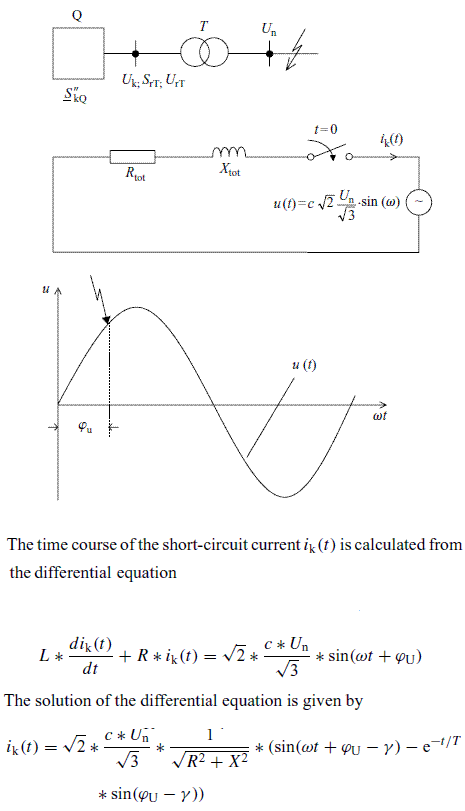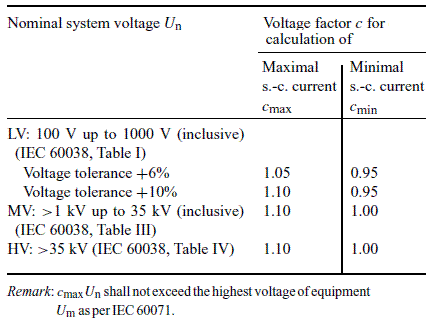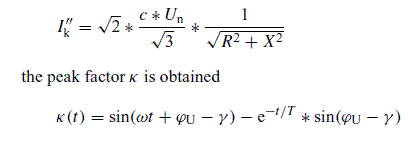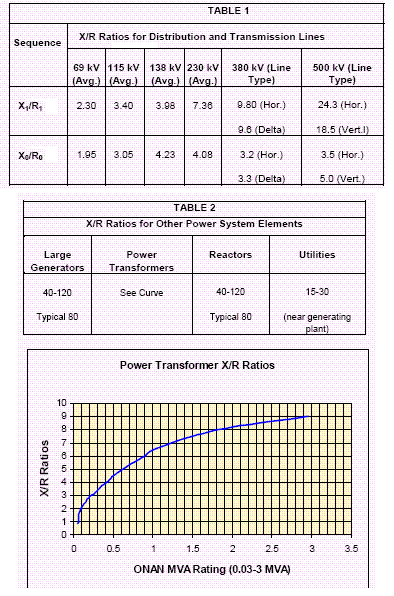مدار معادل تونن اکثر شبکه های قدرت با راکتانس و رزیستانس معادل آنها قابل شبیه سازی است و در بیشتر مطالعات قابل استفاده است. بطور کلی عبور شبکه از شرایط گذرا بستگی به نسبت (X/R) شبکه دارد، که در آن X = ?L معرف راکتانس و R معرف مقاومت اهمی شبکه است. این نسبت در مطالعات پایداری و اتصال کوتاه از اهمیت زیادی برخوردار است. پیک جریان اتصال کوتاه و مدت زمان تداوم مولفه dc آن با افزایش نسبت مذکور اضافه می شود. نرم افزارهای شبیه ساز شبکه نظیر آنچه شما اشاره نمودید، نسبت فوق را بر اساس اطلاعات ورودی محاسبه می کند و آنجا که نیاز است بخشی از شبکه به عنوان یک جعبه سیاه به نرم افزار معرفی شود، می باید معادل تونن آن نیز مشخص شود. برای مثال اگر قرار است یک شبکه محلی کوچک در نقطه ای به یک شبکه بزرگ وصل شود باید سطح اتصال کوتاه و (X/R)شبکه در نقطه اتصال مشخص باشد. در زیر مبانی مداری نسبت مذکور تشریح شده است.  where Un is the nominal system voltage, ϕU is the angle of voltage related to zero crossing as per Figure, c is the voltage factor according to Table below, T is the time constant: T = L/R, X is the reactance of the short-circuit impedance: X = ?L, R is the resistance of the short-circuit impedance, ? is the angular velocity and ? the angle of the short-circuit impedance: ? = arctan(X/R).
where Un is the nominal system voltage, ϕU is the angle of voltage related to zero crossing as per Figure, c is the voltage factor according to Table below, T is the time constant: T = L/R, X is the reactance of the short-circuit impedance: X = ?L, R is the resistance of the short-circuit impedance, ? is the angular velocity and ? the angle of the short-circuit impedance: ? = arctan(X/R).  The initial short-circuit current I”k is equal to the first part (periodic term) of above Equation, the second term is the aperiodic and decaying d.c.-component of the current. If the time course of the short-circuit current as per Equation is related to the peak value of the initial short-circuit current
The initial short-circuit current I”k is equal to the first part (periodic term) of above Equation, the second term is the aperiodic and decaying d.c.-component of the current. If the time course of the short-circuit current as per Equation is related to the peak value of the initial short-circuit current  The maximum of the peak factor ? determines the maximum of the short-circuit current (peak short-circuit current ip) to be calculated by partial differentiation of Equation with respect to ϕU and t . The maximum of the peak factor always occurs for short-circuits at ϕU = 0 and t ? 10 ms (50 Hz), respectively t ? 8.33 ms (60 Hz), whatever the ratio R/X might be
The maximum of the peak factor ? determines the maximum of the short-circuit current (peak short-circuit current ip) to be calculated by partial differentiation of Equation with respect to ϕU and t . The maximum of the peak factor always occurs for short-circuits at ϕU = 0 and t ? 10 ms (50 Hz), respectively t ? 8.33 ms (60 Hz), whatever the ratio R/X might be  Special attention for the calculation of peak short-circuit current must be given in the case of short-circuits in meshed systems or in systems having parallel lines with R/X-ratios different from each other. A detailed analysis of these conditions is given in IEC 60909-1.
Special attention for the calculation of peak short-circuit current must be given in the case of short-circuits in meshed systems or in systems having parallel lines with R/X-ratios different from each other. A detailed analysis of these conditions is given in IEC 60909-1.

